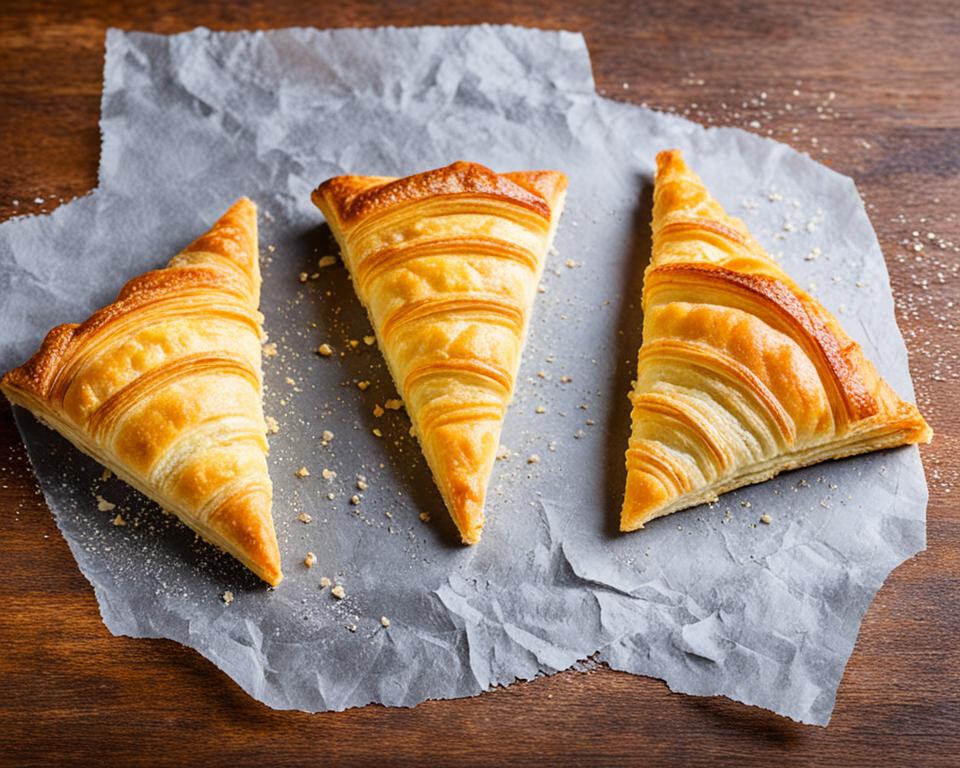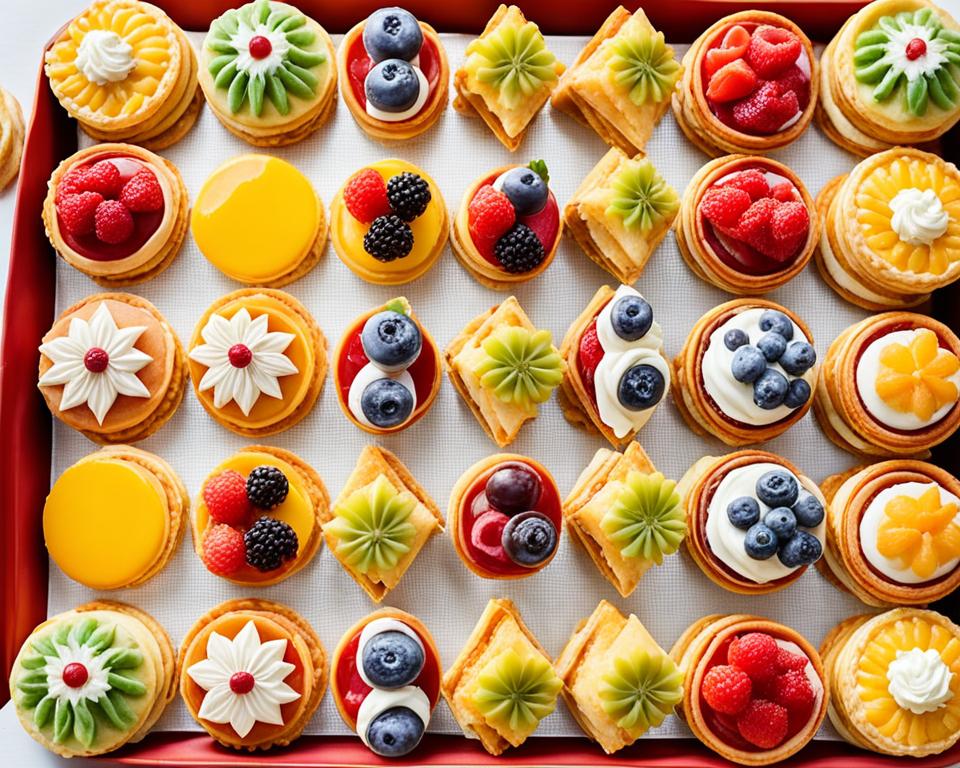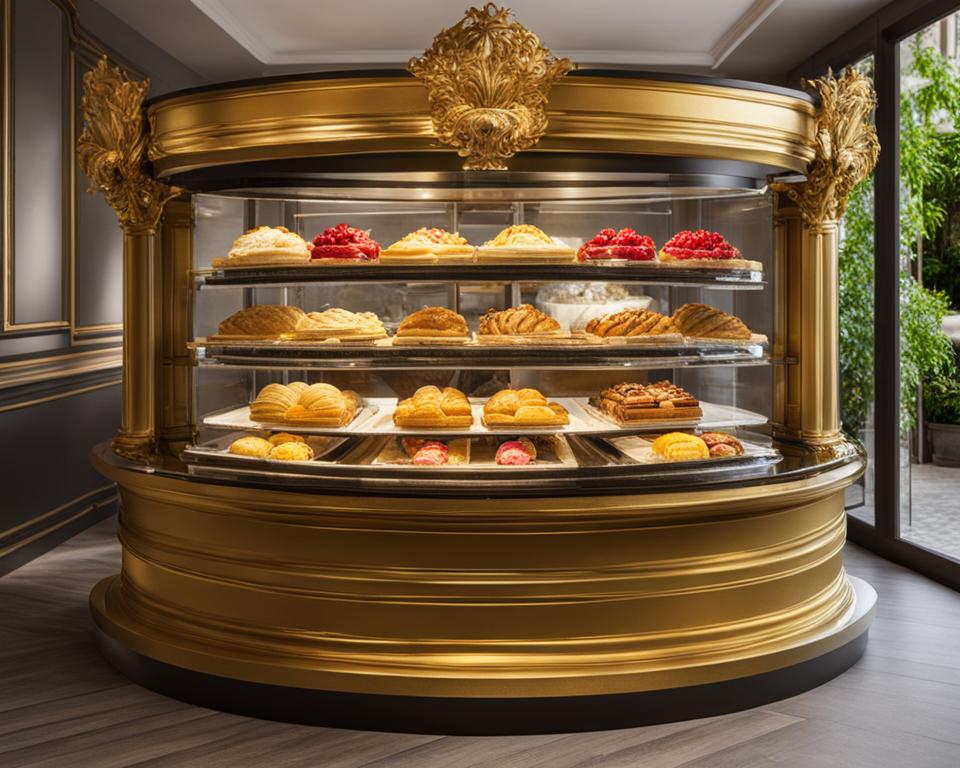Flaky pastry and puff pastry are two types of layered pastries that are often used interchangeably. However, there are differences in their ingredients, methods, and characteristics. Flaky pastry contains a higher proportion of fat to flour compared to shortcrust pastry and is made by rubbing fat into the flour. On the other hand, puff pastry is made by layering butter between dough and rolling it out to create multiple layers. These differences affect the texture and rise of the pastries, as well as the amount of time and effort required to make them.
- Flaky pastry and puff pastry are two types of layered pastries.
- Flaky pastry has a higher proportion of fat to flour and is made by rubbing fat into the flour.
- Puff pastry is made by layering butter between dough and rolling it out to create layers.
- Flaky pastry has a crumbly texture and a slightly less pronounced rise compared to puff pastry.
- Puff pastry has a light and delicate texture with a high rise.
The Recipes for Flaky and Puff Pastry
Both flaky pastry and puff pastry can be made using similar ingredients to create delicious, buttery pastries. Let’s take a look at the recipes for each:
Flaky Pastry Recipe
To make flaky pastry, you will need the following ingredients:
- 2 cups plain white flour
- 1/2 teaspoon salt
- 3/4 cup unsalted butter, chilled and cubed
- 1/2 cup cold water
Here’s how to make it:
- In a large mixing bowl, combine the flour and salt.
- Add the chilled butter cubes to the flour mixture.
- Using your fingertips or a pastry cutter, rub the butter into the flour until it resembles coarse crumbs.
- Add the cold water, a little at a time, and mix until the dough comes together.
- Transfer the dough onto a floured surface and knead it gently until smooth.
- Wrap the dough in plastic wrap and refrigerate for at least 30 minutes before using.
This flaky pastry recipe yields a dough that is easy to handle and produces a delightful, crumbly texture in the final baked goods.
Puff Pastry Recipe
To make puff pastry, you will need the following ingredients:
- 2 1/2 cups plain white flour
- 1 teaspoon salt
- 1 1/4 cups unsalted butter, chilled
- 1/2 cup cold water
Here’s how to make it:
- In a large mixing bowl, combine the flour and salt.
- Cut the cold butter into small cubes and add them to the flour mixture.
- Using a pastry blender or your fingertips, incorporate the butter cubes into the flour until the mixture resembles coarse crumbs.
- Add the cold water and mix until the dough comes together.
- Transfer the dough onto a floured surface and knead it gently until smooth.
- Roll out the dough into a rectangle and fold it into thirds like a letter.
- Rotate the dough 90 degrees, roll it out again, and fold it into thirds.
- Repeat the rolling and folding process two more times.
- Wrap the dough in plastic wrap and refrigerate for at least 30 minutes before using.
This puff pastry recipe creates a light, flaky texture with distinct layers that puff up beautifully when baked.
Now that you have the recipes for both flaky and puff pastry, you can choose the one that best suits your baking needs. Whether you’re making savory pies or sweet pastries, these homemade pastries will elevate your culinary creations.
| Pastry Type | Ingredients | Method | Characteristics |
|---|---|---|---|
| Flaky Pastry | Plain white flour, salt, unsalted butter, cold water | Rub butter into flour, add water, roll out and fold | Crumbly texture, less pronounced rise |
| Puff Pastry | Plain white flour, salt, unsalted butter, cold water | Enclose butter in dough, roll out and fold | Light, delicate texture, high rise |
Characteristics of Flaky Pastry
Flaky pastry is a versatile and delicious option for creating delectable baked goods. Let’s explore the key characteristics of flaky pastry and understand why it is a popular choice in the culinary world.
Crumbly Texture and Partial Rise
Flaky pastry has a distinct crumbly texture that adds an enjoyable mouthfeel to your baked treats. Unlike puff pastry, which rises dramatically, flaky pastry offers a more subtle and partial rise. This characteristic gives your pastries a delicate yet satisfying bite.
While the layers in flaky pastry are not as delicate and even as those in puff pastry, they still contribute to the overall flakiness of the final product. Each layer adds a delightful flaky texture that enhances the overall culinary experience.
Perfect for Pie Crusts, Turnovers, and More
Flaky pastry is a popular choice for a variety of sweet and savory dishes. Its slightly less puffy texture makes it ideal for creating pie crusts that are sturdy yet delightfully crumbly. Whether you’re baking a fruit pie or a savory quiche, flaky pastry provides the perfect base.
In addition to pie crusts, flaky pastry is also commonly used in turnovers, palmiers, and other pastries that benefit from a crumbly, flaky texture. Its versatility allows you to explore various fillings and flavor combinations, creating endless culinary possibilities.
Easier to Work With and Faster to Make
Compared to puff pastry, flaky pastry is easier to work with and has a shorter production time. Its method of preparation involves rubbing the fat into the flour and then adding water to bring the mixture to a soft dough. The dough is then rolled out and folded to create the desired layers.
This simplified process saves time and effort while still delivering a deliciously flaky result. Whether you’re a seasoned baker or a beginner in the kitchen, flaky pastry is a great choice for achieving impressive baked goods without the complexity of puff pastry.
| Flaky Pastry | Puff Pastry |
|---|---|
| Crumbly texture | Exceptionally light and delicate texture |
| Slightly less pronounced rise | High rise |
| Well-suited for pie crusts, turnovers, and other applications where a slightly less puffy texture is desired | Ideal for vol-au-vents, bouchees, and other applications where a pronounced rise and delicate layers are desired |
| Easier to work with and has a shorter production time | Requires more time and effort to make |
Flaky pastry is a fantastic choice when you want to achieve a crumbly texture and a partial rise in your baked goods. Its versatility and ease of preparation make it a go-to option for pies, turnovers, and more. While puff pastry may have a more dramatic rise, flaky pastry offers its own unique charm that will delight your taste buds.
Characteristics of Puff Pastry
Puff pastry is known for its distinct characteristics that make it a favorite among pastry enthusiasts. Here, we’ll explore the unique attributes of puff pastry that set it apart from other types of pastries.
Puff pastry has a light and delicate texture that practically melts in your mouth. When baked, the layers in puff pastry rise dramatically, resulting in a pastry that is incredibly light and flaky.
The key to the impressive rise of puff pastry lies in its thin and even layers. The dough is folded multiple times, encasing layers of butter, which creates a laminated structure. As the pastry bakes, the butter between the layers creates steam, causing the dough to expand and puff up.

This make puff pastry ideal for a variety of applications where a pronounced rise and delicate, flaky texture are desired. It is often used to create stunning vol-au-vents, which are elegant puff pastry shells filled with savory or sweet fillings. Puff pastry is also commonly used to craft bite-sized bouchees, which are perfect for serving as appetizers or hors d’oeuvres.
While puff pastry offers exceptional texture and flavor, it requires more time and effort to make compared to other pastries. The process involves multiple rolling and folding steps to create the intricate layers that give puff pastry its signature rise and flakiness.
To summarize, puff pastry is prized for its light and delicate texture, as well as its impressive rise. Its thin and even layers result in a pastry that puffs up dramatically when baked, making it perfect for creating elegant and visually stunning dishes.
Rough Puff Pastry
When it comes to creating delicious pastries without the fuss, rough puff pastry is the way to go. This simplified version of puff pastry provides a perfect blend of flakiness and puffiness, all while saving time and effort. Instead of layering a block of butter, rough puff pastry incorporates diced or grated cold butter and lard into the flour. The result is a pastry that achieves a respectable rise and a delightful flakiness.
With its versatility, rough puff pastry can be used in various sweet and savory applications. It’s perfect for creating delectable sausage rolls, hearty pies, and tantalizing tarts. The possibilities are endless!
Let me share with you a rough puff pastry recipe that is sure to impress:
Rough Puff Pastry Recipe
- In a mixing bowl, combine 2 cups of all-purpose flour and a pinch of salt.
- Add 1/2 cup of diced cold butter and 1/4 cup of grated cold lard.
- Using your fingertips, rub the fat into the flour until the mixture resembles breadcrumbs.
- Gradually add cold water, about 6-8 tablespoons, and mix until the dough comes together.
- Turn the dough out onto a floured surface and gently knead it a few times until smooth.
- Shape the dough into a rectangle, then roll it out lengthwise into a larger rectangle.
- Fold the top third of the dough down, then fold the bottom third over it, like folding a letter.
- Rotate the dough 90 degrees and roll it out again into a rectangle.
- Repeat the folding process two more times, then wrap the dough in plastic wrap and refrigerate for at least 30 minutes before using.
And there you have it! A simple, yet delicious rough puff pastry ready to elevate your culinary creations. Now you can impress your family and friends with your homemade pastries without spending hours in the kitchen.
So go ahead and give this rough puff pastry recipe a try. You won’t be disappointed!
Choosing Between Flaky, Puff, and Rough Puff Pastry
When it comes to choosing between flaky pastry, puff pastry, and rough puff pastry, there are a few factors to consider. The decision depends on your desired rise, the amount of effort and time you have, and the specific application. Let’s explore the differences to help you make an informed choice.
Flaky Pastry:
Flaky pastry offers a slightly less pronounced rise compared to puff pastry. It is easier to work with and quicker to make, making it a convenient option for various recipes. The texture is crumbly, and the layers contribute to the flakiness of the final product.
Puff Pastry:
Puff pastry, on the other hand, offers the highest rise and the most delicate texture. The layers are very thin and even, resulting in a pastry that puffs up dramatically when baked. However, it requires more time and effort to make, as it involves multiple rolling and folding steps.
Rough Puff Pastry:
If you’re looking for a compromise between flaky and puff pastry, rough puff pastry is an excellent choice. It provides a respectable rise and flakiness, similar to puff pastry, but with less effort. The method of making it involves incorporating diced or grated cold butter and lard into the flour, saving preparation time.
In most cases, flaky, puff, and rough puff pastry are interchangeable. You can choose based on personal preference and convenience. Consider the recipe’s requirements, the time and effort you can allocate, and the desired outcome.
To summarize:
- Flaky pastry: Convenient, less pronounced rise, crumbly texture
- Puff pastry: Highest rise, delicate texture, more time and effort required
- Rough puff pastry: Compromise between flaky and puff pastry, respectable rise, less effort
Ultimately, the choice is yours. Experiment with different types of pastry to find your favorite and create delicious treats!
Tips for Making Flaky and Puff Pastry
To achieve the best results when making flaky and puff pastry, it is important to keep the ingredients and the dough as cold as possible. This helps prevent the butter from melting and being absorbed by the flour, which can result in a loss of flakiness.
Here are some tips to help you make perfect flaky and puff pastry:
- Chill the Ingredients: Before starting the pastry-making process, make sure your butter, water, and even the flour are chilled. This will help maintain the proper temperature and keep the butter from softening too quickly.
- Rolling and Folding: Both flaky and puff pastry involve rolling and folding the dough to create layers. It is important to follow the specific instructions for each recipe, including giving the required number of turns and chilling the dough at various stages. This helps create distinct layers and ensures flakiness.
- Use High-Proof Alcohol: Adding a small amount of high-proof alcohol, such as vodka, to the dough can help reduce gluten development. This results in a more tender and flaky pastry.
- Don’t Overwork the Dough: Overworking the dough can lead to gluten development, which can result in a tougher pastry. Handle the dough as little as possible and avoid excessive kneading or stretching.
- Be Mindful of Temperature: Throughout the pastry-making process, it is crucial to keep the dough and work surface cool. If the dough becomes too warm, it can cause the butter to melt and compromise the flaky texture. Return the dough to the refrigerator if it starts to feel soft.
By following these tips and techniques, you can create homemade flaky and puff pastry that is light, buttery, and irresistibly delicious.
Remember, practice makes perfect, so don’t be discouraged if your first attempt doesn’t turn out exactly as you imagined. With time and experience, you’ll master the art of making flaky and puff pastry.

Extra Tip: Time-Saving Alternatives
If you’re short on time or looking for a quicker alternative to making flaky or puff pastry from scratch, consider using store-bought options. Many supermarkets offer pre-made puff and flaky pastry dough, which can be a convenient option for busy cooks.
However, keep in mind that store-bought pastry may not achieve the same level of flakiness and flavor as homemade. So, if you have the time and patience, we recommend trying your hand at making flaky or puff pastry from scratch at least once for the ultimate culinary experience.
Other Types of Pastry
Flaky and puff pastry are not the only types of pastry available. There are many other variations and recipes that can be used as alternatives to flaky and puff pastry. Let’s explore some of these delicious options:
Shortcrust Pastry
Shortcrust pastry is a versatile pastry that is easy to make and is suitable for both sweet and savory dishes. It is made by combining flour, fat (such as butter or lard), and a small amount of liquid. Shortcrust pastry is great for making pie crusts, tarts, quiches, and even sweet desserts like fruit crumbles.
Choux Pastry
Choux pastry is a unique type of pastry that is used to make light and airy pastries, such as profiteroles, eclairs, and cream puffs. It is made by boiling water and butter together before adding flour and eggs. The high moisture content in choux pastry creates steam when baked, resulting in a hollow interior that can be filled with various sweet or savory fillings.
Filo Pastry
Filo pastry, also known as phyllo pastry, is a thin and delicate pastry that is commonly used in Mediterranean and Middle Eastern cuisine. It is made by rolling layers of dough very thinly, resulting in a paper-thin pastry that becomes crispy when baked. Filo pastry is often used for making baklava, spanakopita, and samosas.
| Pastry Type | Characteristics | Applications |
|---|---|---|
| Shortcrust Pastry | Versatile, easy to make | Pie crusts, tarts, quiches, fruit crumbles |
| Choux Pastry | Light and airy | Profiteroles, eclairs, cream puffs |
| Filo Pastry | Thin and delicate | Baklava, spanakopita, samosas |
These are just a few examples of the many other types of pastry that can be used as alternatives to flaky and puff pastry. Each type has its own unique characteristics and applications, allowing you to explore a world of flavors and textures.
Common Uses for Flaky and Puff Pastry
Flaky pastry and puff pastry offer a wide range of culinary possibilities with their distinct textures and versatility. Let’s explore the common uses for these delectable pastries:
Flaky Pastry
Flaky pastry, known for its crumbly and delicate texture, is a perfect choice for various sweet and savory dishes. Here are some popular uses:
- Pie crusts: Flaky pastry creates a buttery and flaky base for delicious fruit, custard, or meat pies. Its crumbly texture complements the filling and adds a delightful contrast.
- Turnovers: Whether filled with fruits, vegetables, or cheeses, flaky pastry turnovers make a delectable handheld treat for any time of the day.
- Palmiers: These elegant heart-shaped pastries, also known as elephant ears, are made by rolling flaky pastry with sugar and baking until caramelized. They make a delightful sweet snack or coffee companion.
Puff Pastry
Puff pastry is renowned for its light, airy layers that rise beautifully when baked. Its versatility makes it a go-to choice for a wide range of culinary creations. Here are some common uses:
- Vol-au-vents: These delicate, hollow pastries are perfect for creating elegant appetizers or bite-sized hors d’oeuvres. Fill them with creamy seafood, mushroom, or vegetable fillings for a burst of flavor.
- Bouchees: These bite-sized puff pastry cups are like miniature bowls, perfect for holding savory or sweet fillings. They are ideal for serving at parties or as an appetizer for special occasions.
- Sausage rolls: Puff pastry encases seasoned sausage meat, creating a savory and flaky treat that’s a hit at picnics, parties, or as a delicious snack.
No matter the choice of pastry, flaky or puff, both can be filled with an array of sweet or savory ingredients, expanding the culinary possibilities even further. So, why not unleash your creativity and impress your guests with these delightful pastries?
| Flaky Pastry | Puff Pastry |
|---|---|
| Crumbly and flaky texture | Light and airy layers |
| Perfect for pie crusts | Ideal for vol-au-vents and bouchees |
| Delicious turnovers and palmiers | Savory sausage rolls |
Conclusion
In conclusion, flaky and puff pastry are both popular types of layered pastries, each with its own distinct characteristics and preparation methods. Flaky pastry, with its crumbly texture, is easier to make compared to puff pastry. It offers a slightly less pronounced rise but still contributes to a delightful flakiness in baked goods. On the other hand, puff pastry is renowned for its delicate layers, dramatic rise, and light texture. Although it requires more time and effort to prepare, the results are truly impressive.
For those seeking a middle ground between flaky and puff pastry, rough puff pastry provides a wonderful compromise. With diced or grated cold butter and lard incorporated into the dough, it offers a respectable rise and flakiness without the extensive rolling and folding required for puff pastry. The choice between these three types of pastry ultimately depends on personal preference and the specific application.
It’s worth noting that the world of pastry extends beyond flaky and puff varieties. Shortcrust pastry, choux pastry, and filo pastry are just a few examples of other types that offer different textures and culinary possibilities. From versatile shortcrust for both sweet and savory dishes to delicate filo with its paper-thin layers, there is a pastry to suit every taste and recipe.
As we conclude our exploration of flaky and puff pastry, it’s clear that both types bring their unique qualities to the table. Whether you prefer the crumbly texture of flaky pastry, the airy layers of puff pastry, or the convenience of rough puff pastry, there is no shortage of delicious creations to be made. So, go ahead and indulge your culinary creativity with these versatile and delightful pastries.
FAQ
What is the difference between flaky and puff pastry?
Flaky pastry and puff pastry are two types of layered pastries that share similarities but also have differences in their ingredients, methods, and characteristics.
Are the recipes for flaky and puff pastry the same?
The recipes for flaky pastry and puff pastry have similarities in terms of ingredients such as flour, fat, and water, but the methods and techniques differ.
What are the characteristics of flaky pastry?
Flaky pastry has a crumbly texture with slightly less pronounced layers compared to puff pastry. It is well-suited for pie crusts, turnovers, and other applications that require a less puffy texture.
What are the characteristics of puff pastry?
Puff pastry has a light and delicate texture with a high rise. Its layers are thin and even, resulting in a pastry that puffs up dramatically when baked. It is used for applications that require a pronounced rise and delicate, flaky texture.
What is rough puff pastry?
Rough puff pastry is a simplified version of puff pastry that provides a good compromise between flaky and puff pastry. It is made by incorporating diced or grated cold butter and lard into the flour, rather than layering a block of butter.
How do I choose between flaky, puff, and rough puff pastry?
The choice between flaky, puff, and rough puff pastry depends on factors such as the desired rise, the amount of effort and time available, and the specific application. Each type of pastry has its own characteristics and uses.
What are some tips for making flaky and puff pastry?
To achieve the best results when making flaky and puff pastry, it is important to keep the ingredients and the dough as cold as possible. It is also important to follow specific recipe instructions, including chilling the dough at various stages and giving the required number of turns.
Are there other types of pastry besides flaky and puff?
Yes, there are many other types of pastry, such as shortcrust pastry, choux pastry, and filo pastry, each with its own characteristics and applications.
What are the common uses for flaky and puff pastry?
Flaky pastry is commonly used for pie crusts, turnovers, palmiers, and other pastries that benefit from a crumbly, flaky texture. Puff pastry is often used for vol-au-vents, bouchees, sausage rolls, and other applications where a high rise and delicate layers are desired.
What is the conclusion of the difference between flaky and puff pastry?
Flaky and puff pastry are both layered pastries with different methods of preparation and characteristics. Flaky pastry has a slightly less pronounced rise and is easier to make compared to puff pastry. Puff pastry offers a higher rise and a delicate texture but requires more time and effort. Rough puff pastry provides a good compromise between flaky and puff pastry. Other types of pastry offer even more variety in texture and uses.




